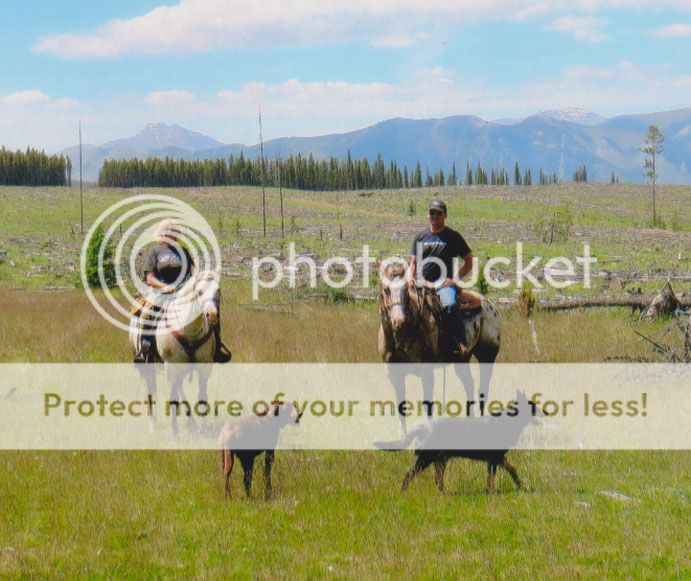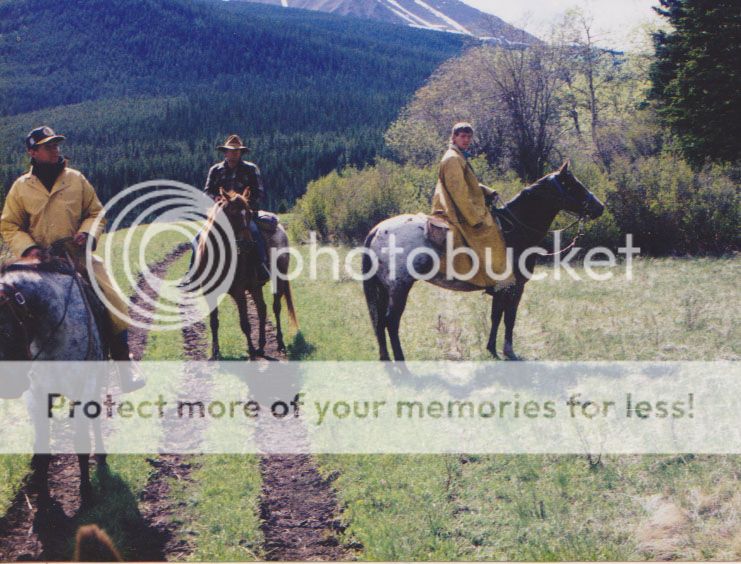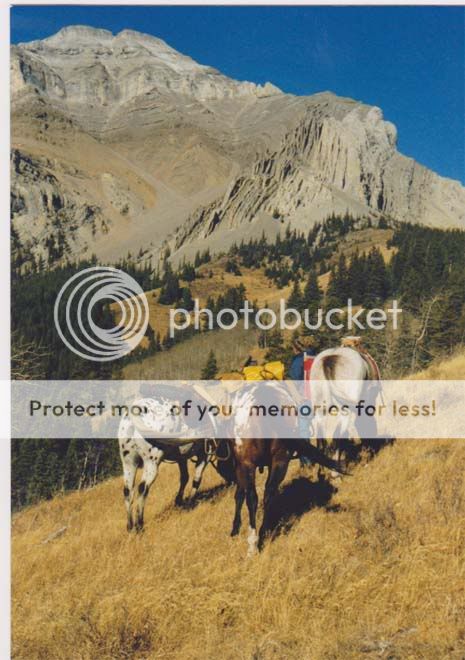The title describes a serious problem for me with Hondo. If I cannot figure out how to help him get over it, or at least reduce to a brace, I'm beginning to think it may only be a matter of time before I am seriously injured.
Hondo is not spooky as in at strange objects along the road or trail. Bulldozers, cars, barrels, etc in a different spot than before is noticed but not spooked at. Doesn't spook at rocks, stumps, etc. He is a good willing horse that will do anything that I ask of him.
But he will startle big time at anything unusual that moves. He has done this since he was first bought by the ranch. He was ridden for a year or two by a very experienced rider that was raised on the ranch. He was finally taken out of service when a huge spook at a gallop almost threw the rider. This particular rider has trained horses born on the ranch and ridden them to retirement so no novice at all.
The last startle/spook/spin unloaded me and even though I had a helmet on I rang my bell pretty well.
We were traveling down a ranch road at a slow walk that leads to a barn/corral about 1.5 miles away. Ridden the road many times. About midway I noticed a cow ahead off to the right a few feet in an unusual spot. Looked like a cow I had seen with a new calf hanging around the barn and was studying her to see if it was her. (yes looking at her) As we neared she shifted a little and Hondo apparently first saw her. After he shied, spun, and did his bolt I had that sick feeling that I was coming off.
As usual, he stopped within about 50 feet looking at me and the cow. I got up, walked to him, remounted, and we rode on. (i'm still sore)
This is a typical event that has happened about 8 or so times in the last year. I've made it to the ground on three of them. It was only this and one other time that I even knew what it was he spooked at.
I am a novice rider. I know I need a better seat. I know I need lessons. Nearest lessons are 50 miles away and isn't going to happen. Hondo is my first horse and likely my last and if I can't learn how to "fix" this myself, it just ain't going to happen.
Other than this, Hondo is the perfect horse, for me. He will do anything I ask. Herd cattle, sort in the pen, sidepass for opening/closing gates. Great feet in the rocks. Veritable mountain goat. I walk out in the herd to get him and he literally sticks his nose into the halter. Most of our rides are solo and go very well. And I've developed a deep bond to him.
Before anyone suggests getting rid of him and getting another horse, that's just not in the cards I'm holding. And if I could get another horse, which I can't at this time at least, I'd have to keep Hondo anyhow. I'm that bonded. I become very attached to animals in my care.
I've read Cherie's posts and other threads on similar problems. And out of desperation I ordered magnesium calming supplement just last night. Can't hurt, might help. Does for some, doesn't for others.
I thought, or was hoping, that after time he would perhaps change. It's been a year now and I don't see much if any change in his startle. Well, not true. He used to brace at flocks of birds, single birds, and even large butterflies sometimes. Seldom braces at little stuff anymore. So there has been improvement. But the big spin/bolt is still there. And he always stops within a few feet to see what it actually was that startled him.
I am willing to spend any amount of time with anything that has a promise of a possibility of working.
Hondo is 14, I am 73 and would like to ride him for the next ten years, or more.
I'll add that on most rides he appears a little paranoid wanting to look right and left as we travel at first. That behavior does seems to mostly dissipate within a mile or so.
Although it may be true that my riding style, confidence, etc may or may not be affecting him, please remember he has been this way long before I acquired him and was given up on by a rider that is absolutely fearless charging through the heavy brush and rocks. I was flat out told Hondo was not safe to ride at a gallop but he might be ok for me at a walk only.
Thanks, Harold
Hondo is not spooky as in at strange objects along the road or trail. Bulldozers, cars, barrels, etc in a different spot than before is noticed but not spooked at. Doesn't spook at rocks, stumps, etc. He is a good willing horse that will do anything that I ask of him.
But he will startle big time at anything unusual that moves. He has done this since he was first bought by the ranch. He was ridden for a year or two by a very experienced rider that was raised on the ranch. He was finally taken out of service when a huge spook at a gallop almost threw the rider. This particular rider has trained horses born on the ranch and ridden them to retirement so no novice at all.
The last startle/spook/spin unloaded me and even though I had a helmet on I rang my bell pretty well.
We were traveling down a ranch road at a slow walk that leads to a barn/corral about 1.5 miles away. Ridden the road many times. About midway I noticed a cow ahead off to the right a few feet in an unusual spot. Looked like a cow I had seen with a new calf hanging around the barn and was studying her to see if it was her. (yes looking at her) As we neared she shifted a little and Hondo apparently first saw her. After he shied, spun, and did his bolt I had that sick feeling that I was coming off.
As usual, he stopped within about 50 feet looking at me and the cow. I got up, walked to him, remounted, and we rode on. (i'm still sore)
This is a typical event that has happened about 8 or so times in the last year. I've made it to the ground on three of them. It was only this and one other time that I even knew what it was he spooked at.
I am a novice rider. I know I need a better seat. I know I need lessons. Nearest lessons are 50 miles away and isn't going to happen. Hondo is my first horse and likely my last and if I can't learn how to "fix" this myself, it just ain't going to happen.
Other than this, Hondo is the perfect horse, for me. He will do anything I ask. Herd cattle, sort in the pen, sidepass for opening/closing gates. Great feet in the rocks. Veritable mountain goat. I walk out in the herd to get him and he literally sticks his nose into the halter. Most of our rides are solo and go very well. And I've developed a deep bond to him.
Before anyone suggests getting rid of him and getting another horse, that's just not in the cards I'm holding. And if I could get another horse, which I can't at this time at least, I'd have to keep Hondo anyhow. I'm that bonded. I become very attached to animals in my care.
I've read Cherie's posts and other threads on similar problems. And out of desperation I ordered magnesium calming supplement just last night. Can't hurt, might help. Does for some, doesn't for others.
I thought, or was hoping, that after time he would perhaps change. It's been a year now and I don't see much if any change in his startle. Well, not true. He used to brace at flocks of birds, single birds, and even large butterflies sometimes. Seldom braces at little stuff anymore. So there has been improvement. But the big spin/bolt is still there. And he always stops within a few feet to see what it actually was that startled him.
I am willing to spend any amount of time with anything that has a promise of a possibility of working.
Hondo is 14, I am 73 and would like to ride him for the next ten years, or more.
I'll add that on most rides he appears a little paranoid wanting to look right and left as we travel at first. That behavior does seems to mostly dissipate within a mile or so.
Although it may be true that my riding style, confidence, etc may or may not be affecting him, please remember he has been this way long before I acquired him and was given up on by a rider that is absolutely fearless charging through the heavy brush and rocks. I was flat out told Hondo was not safe to ride at a gallop but he might be ok for me at a walk only.
Thanks, Harold












